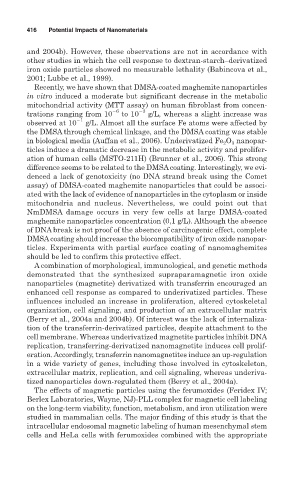Page 436 - Environmental Nanotechnology Applications and Impacts of Nanomaterials
P. 436
416 Potential Impacts of Nanomaterials
and 2004b). However, these observations are not in accordance with
other studies in which the cell response to dextran-starch–derivatized
iron oxide particles showed no measurable lethality (Babincova et al.,
2001; Lubbe et al., 1999).
Recently, we have shown that DMSA-coated maghemite nanoparticles
in vitro induced a moderate but significant decrease in the metabolic
mitochondrial activity (MTT assay) on human fibroblast from concen-
6 3
trations ranging from 10 to 10 g/L, whereas a slight increase was
1
observed at 10 g/L. Almost all the surface Fe atoms were affected by
the DMSA through chemical linkage, and the DMSA coating was stable
in biological media (Auffan et al., 2006). Underivatized Fe O nanopar-
2
3
ticles induce a dramatic decrease in the metabolic activity and prolifer-
ation of human cells (MSTO-211H) (Brunner et al., 2006). This strong
difference seems to be related to the DMSAcoating. Interestingly, we evi-
denced a lack of genotoxicity (no DNA strand break using the Comet
assay) of DMSA-coated maghemite nanoparticles that could be associ-
ated with the lack of evidence of nanoparticles in the cytoplasm or inside
mitochondria and nucleus. Nevertheless, we could point out that
NmDMSA damage occurs in very few cells at large DMSA-coated
maghemite nanoparticles concentration (0,1 g/L). Although the absence
of DNA break is not proof of the absence of carcinogenic effect, complete
DMSAcoating should increase the biocompatibility of iron oxide nanopar-
ticles. Experiments with partial surface coating of nanomaghemites
should be led to confirm this protective effect.
A combination of morphological, immunological, and genetic methods
demonstrated that the synthesized supraparamagnetic iron oxide
nanoparticles (magnetite) derivatized with transferrin encouraged an
enhanced cell response as compared to underivatized particles. These
influences included an increase in proliferation, altered cytoskeletal
organization, cell signaling, and production of an extracellular matrix
(Berry et al., 2004a and 2004b). Of interest was the lack of internaliza-
tion of the transferrin-derivatized particles, despite attachment to the
cell membrane. Whereas underivatized magnetite particles inhibit DNA
replication, transferring-derivatized nanomagnetite induces cell prolif-
eration. Accordingly, transferrin nanomagnetites induce an up-regulation
in a wide variety of genes, including those involved in cytoskeleton,
extracellular matrix, replication, and cell signaling, whereas underiva-
tized nanoparticles down-regulated them (Berry et al., 2004a).
The effects of magnetic particles using the ferumoxides (Feridex IV;
Berlex Laboratories, Wayne, NJ)-PLL complex for magnetic cell labeling
on the long-term viability, function, metabolism, and iron utilization were
studied in mammalian cells. The major finding of this study is that the
intracellular endosomal magnetic labeling of human mesenchymal stem
cells and HeLa cells with ferumoxides combined with the appropriate

